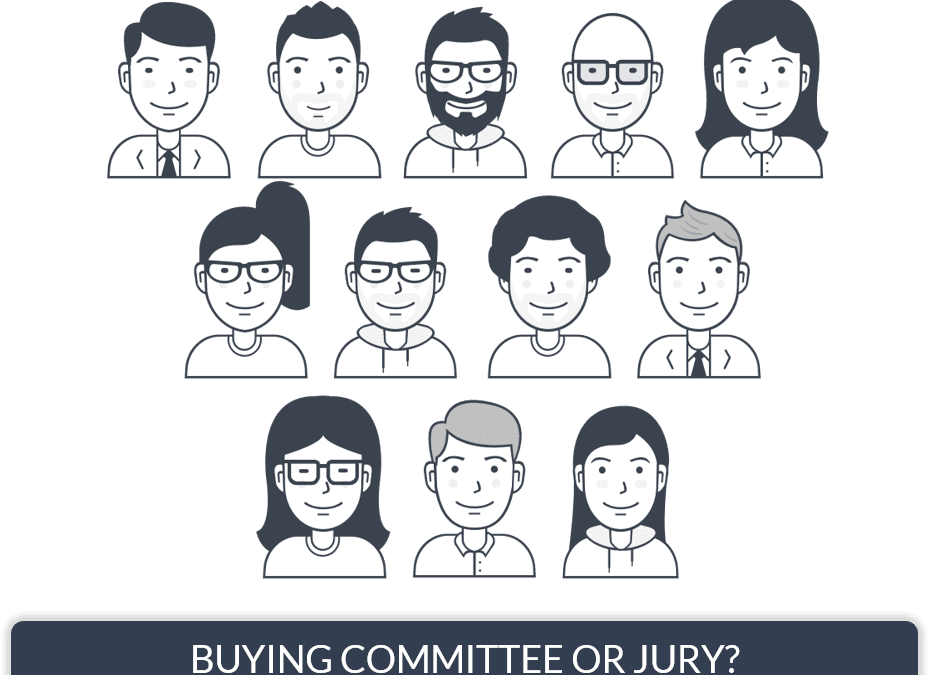Which means that sellers need to up their game.
The growth of the Buying Committee, Decision Making Unit or whatever you choose to call them has led to selling becoming far more about people strategy and management.
The objective for sales teams is to convince a wider collection of buyers (people) from across an organisation to make a decision, not only a decision to make a business change but also a decision to to choose them.
Why are they like a jury?
A jury is a group of people (typically twelve in number) who come together to reach a verdict in a legal case on the basis of evidence submitted to them in court.
Both sets of lawyers will assess each member of the jury and their questioning, evidence and closing summaries are all designed to influence each juror to come down on their side.
When they can’t reach a unanimous or majority agreement on the evidence after hours, days and even weeks in the biggest cases, it becomes a hung jury and the judge will discharge them.
Despite hundreds of hours of legal team preparation, court questioning and arguments the accused is neither acquitted or convicted, neither the defence or prosecution win. There is no decision.
Can you see where I’m going with this?
Thankfully there are way fewer hung juries in courts than there are no-decisions in company buying.
Brace yourself because the next part makes for depressing reading.
Between 40-60% of sales opportunities end with the customers doing diddly squat, zilch, sweet Fanny Adams. If that is not clear, it means they do nothing, they decide to not make a decision on change.
Why are jury’s similar to buying committees?
It’s the number of people and how they make decisions.
Research shows that the typical number is 11+ in B2B buying decisions, this can flex up quite a bit depending on what you sell.
Right off the bat sellers are expected to get a collective yes from a similar number of people that lawyers seek to get a collective guilty or not guilty.
Whether in court or in customer engagements getting this number of people to agree is a challenge.
People by nature have individual thoughts, concerns and opinions, getting them all aligned can be like trying to nail jelly to the ceiling.
Lawyers cannot rely on convincing a few members of the jury and sellers can’t count on a few fans/supporters to get their deal over the line.
Just like a jury decision, buying decisions are not made by one or two people (not often anyway).
And just like in a jury there will be buyers who have stronger voices and influence in the vote than others.
When you think about the number of individuals involved it’s no wonder that customer buying decisions are both difficult to achieve and take much longer than expected and all too often end with the dreaded do-nothing outcome.
That’s not to say it’s impossible because there are plenty of salespeople killing it today, and its not all due to great brand, products or pricing.
Some salespeople are difference makers and know how to identify, engage and enable the wider buying committee to achieve a positive decision.
It’s vital to understand that companies are making committee-based buying decisions because execs and senior leaders seek to achieve consensus within their teams.
What to do?
Lawyers do not take shortcuts in the legal process, and sellers shouldn’t either in the sales process. Sadly, it happens all too often in their buying committee activities.
I would not want a lawyer representing me who didn’t prepare and execute thoroughly, because the jury will likely make an unfavourable decision.
And I think that salespeople who do the same can expect similar buying committee results.
Here are a few things you should do to mitigate the risk and achieve better results:
- Research and map out the typical functional personas involved in recent deals (won and lost). Dig high, wide and deep, leave no stone unturned to ensure you understand how your customer decisions are made and who’s typically involved.
- Once you have a benchmark, identify and engage with the equivalent personas in your opportunities as a starting point.
- Complete buyer discovery for each opportunity because the benchmark is your guide not your limitation, there will be a few extras that might pop onto your radar.
- Understand each buyer and what’s important to them (their challenges, criteria, concerns, position on change etc.)
- Plan the steps to address what you’ve discovered about each buyer that will help influence their recommendation/vote.
The days of relying on one or two well positioned friendly contact buyers to win a deal have gone.
Of course, there will be the odd exception but as a rule you can assume that the number of people involved in buying decisions will be well into double figures.
Failure to acknowledge this and have a strategy will generally end in disappointment, but it doesn’t need to be this way.
Do not assume that contact seniority means power because influence is often more powerful than authority.
Decisions can emanate from any level in the buying committee.
Think like a good lawyer, put the work in.
#BuyingCommittee

